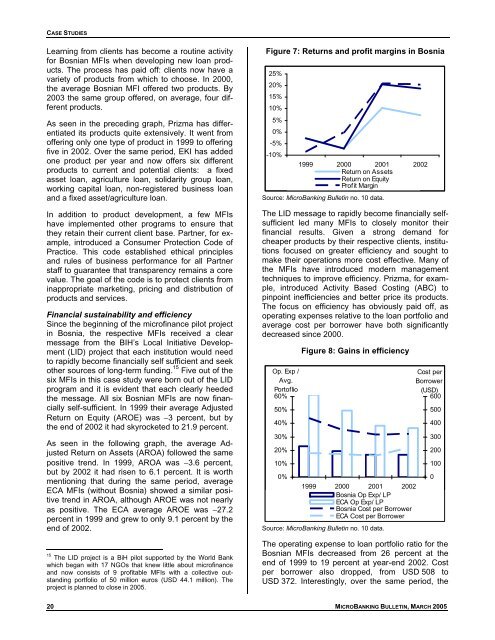Downloading - Microfinance Information Exchange
Downloading - Microfinance Information Exchange
Downloading - Microfinance Information Exchange
You also want an ePaper? Increase the reach of your titles
YUMPU automatically turns print PDFs into web optimized ePapers that Google loves.
CASE STUDIES<br />
Learning from clients has become a routine activity<br />
for Bosnian MFIs when developing new loan products.<br />
The process has paid off: clients now have a<br />
variety of products from which to choose. In 2000,<br />
the average Bosnian MFI offered two products. By<br />
2003 the same group offered, on average, four different<br />
products.<br />
As seen in the preceding graph, Prizma has differentiated<br />
its products quite extensively. It went from<br />
offering only one type of product in 1999 to offering<br />
five in 2002. Over the same period, EKI has added<br />
one product per year and now offers six different<br />
products to current and potential clients: a fixed<br />
asset loan, agriculture loan, solidarity group loan,<br />
working capital loan, non-registered business loan<br />
and a fixed asset/agriculture loan.<br />
In addition to product development, a few MFIs<br />
have implemented other programs to ensure that<br />
they retain their current client base. Partner, for example,<br />
introduced a Consumer Protection Code of<br />
Practice. This code established ethical principles<br />
and rules of business performance for all Partner<br />
staff to guarantee that transparency remains a core<br />
value. The goal of the code is to protect clients from<br />
inappropriate marketing, pricing and distribution of<br />
products and services.<br />
Financial sustainability and efficiency<br />
Since the beginning of the microfinance pilot project<br />
in Bosnia, the respective MFIs received a clear<br />
message from the BIH’s Local Initiative Development<br />
(LID) project that each institution would need<br />
to rapidly become financially self sufficient and seek<br />
other sources of long-term funding. 15 Five out of the<br />
six MFIs in this case study were born out of the LID<br />
program and it is evident that each clearly heeded<br />
the message. All six Bosnian MFIs are now financially<br />
self-sufficient. In 1999 their average Adjusted<br />
Return on Equity (AROE) was −3 percent, but by<br />
the end of 2002 it had skyrocketed to 21.9 percent.<br />
As seen in the following graph, the average Adjusted<br />
Return on Assets (AROA) followed the same<br />
positive trend. In 1999, AROA was −3.6 percent,<br />
but by 2002 it had risen to 6.1 percent. It is worth<br />
mentioning that during the same period, average<br />
ECA MFIs (without Bosnia) showed a similar positive<br />
trend in AROA, although AROE was not nearly<br />
as positive. The ECA average AROE was −27.2<br />
percent in 1999 and grew to only 9.1 percent by the<br />
end of 2002.<br />
15 The LID project is a BiH pilot supported by the World Bank<br />
which began with 17 NGOs that knew little about microfinance<br />
and now consists of 9 profitable MFIs with a collective outstanding<br />
portfolio of 50 million euros (USD 44.1 million). The<br />
project is planned to close in 2005.<br />
Figure 7: Returns and profit margins in Bosnia<br />
25%<br />
20%<br />
15%<br />
10%<br />
5%<br />
0%<br />
-5%<br />
-10%<br />
1999 2000 2001 2002<br />
Return on Assets<br />
Return on Equity<br />
Profit Margin<br />
Source: MicroBanking Bulletin no. 10 data.<br />
The LID message to rapidly become financially selfsufficient<br />
led many MFIs to closely monitor their<br />
financial results. Given a strong demand for<br />
cheaper products by their respective clients, institutions<br />
focused on greater efficiency and sought to<br />
make their operations more cost effective. Many of<br />
the MFIs have introduced modern management<br />
techniques to improve efficiency. Prizma, for example,<br />
introduced Activity Based Costing (ABC) to<br />
pinpoint inefficiencies and better price its products.<br />
The focus on efficiency has obviously paid off, as<br />
operating expenses relative to the loan portfolio and<br />
average cost per borrower have both significantly<br />
decreased since 2000.<br />
Op. Exp /<br />
Avg.<br />
Portoflio<br />
60%<br />
50%<br />
40%<br />
30%<br />
20%<br />
10%<br />
0%<br />
Figure 8: Gains in efficiency<br />
1999 2000 2001 2002<br />
Bosnia Op Exp/ LP<br />
ECA Op Exp/ LP<br />
Bosnia Cost per Borrower<br />
ECA Cost per Borrower<br />
Source: MicroBanking Bulletin no. 10 data.<br />
Cost per<br />
Borrower<br />
(USD)<br />
600<br />
500<br />
400<br />
300<br />
200<br />
100<br />
The operating expense to loan portfolio ratio for the<br />
Bosnian MFIs decreased from 26 percent at the<br />
end of 1999 to 19 percent at year-end 2002. Cost<br />
per borrower also dropped, from USD 508 to<br />
USD 372. Interestingly, over the same period, the<br />
0<br />
20 MICROBANKING BULLETIN, MARCH 2005

















